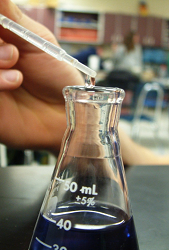Outcomes
A student:
› develops and evaluates questions and hypotheses for scientific investigation CH11/12-1
› designs and evaluates investigations in order to obtain primary and secondary data and information CH11/12-2
› conducts investigations to collect valid and reliable primary and secondary data and information CH11/12-3
› analyses and evaluates primary and secondary data and information CH11/12-5
› describes, explains and quantitatively analyses acids and bases using contemporary models CH12-13
Content Focus
Students analyse how and why the definitions of both an acid and a base have changed over time, and how the current definitions characterise the many chemical reactions of acids. Acids react in particular ways to a variety of substances. These reactions follow a pattern that students identify and explore in detail.
Acids and bases, and their reactions, are used extensively in everyday life and in the human body. The chemistry of acids and bases contributes to industrial contexts and the environment. Therefore, it is essential that the degree of acidity in these situations is continually monitored. By investigating the qualitative and quantitative properties of acids and bases, students learn to appreciate the importance of factors such as pH and indicators.
Working Scientifically
In this module, students focus on developing questions and testing hypotheses through designing, evaluating and conducting investigations to process and analyse data from acid/base reactions. Students should be provided with opportunities to engage with all the Working Scientifically skills throughout the course.
Extract from Chemistry Stage 6 Syllabus © 2017 NSW Education Standards Authority (NESA)

